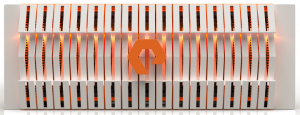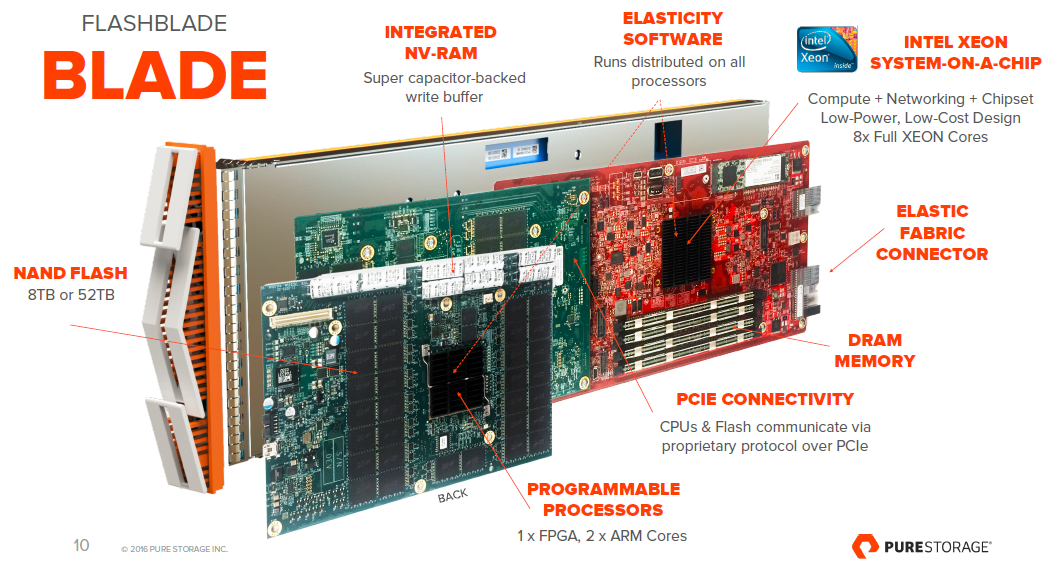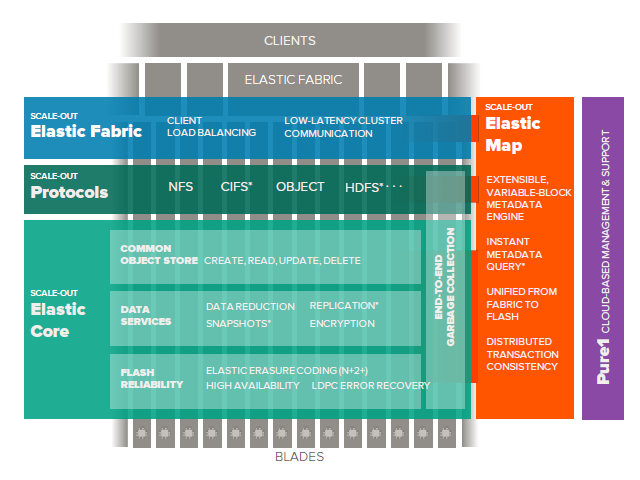![]() Today, Pure Storage made several announcements: new product, new bundled solutions, and a brand-new scale-out architecture. These announcements were timed to coincide with Day One of their first-ever conference event, Pure//Accelerate, which I am attending.
Today, Pure Storage made several announcements: new product, new bundled solutions, and a brand-new scale-out architecture. These announcements were timed to coincide with Day One of their first-ever conference event, Pure//Accelerate, which I am attending.
[DISCLAIMER: In the interest of full disclosure, Pure Storage provided me with a complimentary pass to their conference and also covered my plane fare and hotel costs to attend. That said, there was no requirement that I post anything, nor has Pure reviewed anything I’ve written in this post. The only input they’ve had on this content is being very available to answer any questions I’ve asked.]
The announcements that interested me the most are:
- A new addition to the FlashArray//m Series line of products
- New bundled FlashStack solutions
- A from-the-ground-up new scalable storage architecture
I’ll walk through these in order below.
FlashArray//m10
 Those readers who are already familiar with Pure Storage’s m-Series arrays will recognize the m10 as a smaller model in the series.
Those readers who are already familiar with Pure Storage’s m-Series arrays will recognize the m10 as a smaller model in the series.
With the m10, Pure hopes to capture the branch and remote office market, as well as make themselves more affordable for smaller deployments.
The m10 runs the same software as the rest of the m-Series arrays. Like them, it can be managed from mobile devices by the Pure1 software.
The m10 is available with either 5TB or 10TB raw Flash storage space. With Pure’s inline compression and data deduplication, this gives it an effective capacity of 12.5TB or 25TB.
The FA//m10 is fully-upgradeable to any other model in the m-Series.
With all software included, and participation in Pure’s EverGreen Storage program, starting price for the smaller m10 configuration will be below $50K USD.
New FlashStack Solutions
The Pure Storage FlashStack is an application-specific bundled solution. It is based upon Cisco UCS servers running the application, attached to a Pure Storage array, either the older FA or the newer m-Series.
Offering is the FlashStack line already included:
- VMware vSphere
- VMware Horizon View
- Citrix Xen Desktop
- Oracle
- SAP
- Microsoft SQL Server
The new additions to the FlashStack line announced today are:
- SAP Lumira HANA
- Microsoft Exchange
Additionally, Pure announced the FlashStack Mini. FlashStack Mini is a FlashStack bundled solution that uses the new FlashArray//m10 is the storage base and is designed with the branch office in mind. The initial new FlashStack Mini solutions are:
- VMware Horizon View
- Microsoft Hyper-V
Cisco Verified Design (CVD) documentation for the FlashStack solutions are due out in the second half of 2016.
FlashBlade
 I intentionally put this last in this posting. During the advance briefing I received, I had trouble paying attention to anything Pure Storage talked about after the FlashBlade. (Yes, I found it that interesting and exciting.)
I intentionally put this last in this posting. During the advance briefing I received, I had trouble paying attention to anything Pure Storage talked about after the FlashBlade. (Yes, I found it that interesting and exciting.)
The FlashBlade is Pure’s completely-new architecture. It’s a scale-out Flash system based on 4U chassis. Each chassis can be ordered with a minimum of 7 and a maximum of 15 storage blades.
These blades are the first part of the excitement for me. They doing use SSD, but instead each blade can have either 8TB or 52TB of NAND Flash. This means that a fully-loaded 4U chassis will have 780TB of raw Flash storage with an effective capacity of 1.6PB.
Each blade has eight full Intel Xeon cores running Pure’s new Elasticity software in parallel. Each blade accesses the storage on all the other blades in the chassis over the PCIe backplane.
You can see the details of the individual blade below:
In addition to the hardware being a completely new architecture, the FlashBlade’s operating environment, Elasticity, is also brand-new. It’s designed with both scale-out and data services in mind, using an advanced metadata engine. Pure’s other storage arrays are block storage. FlashBlade is designed for unstructured data, specifically files and objects.
A logical view of the Elasticity design can be seen in the diagram below. Features marked with an asterisk are not available at GA, but are on the roadmap.
Data is stored across all available blades using N+2 erasure coding. This means that a FlashBlade chassis can still serve data even in the event of the failure of two of its blades. For speed and efficiency, Elasticity uses low-density parity-check (LDPC) coding for error recovery.
Elasticity can be managed by Pure1.
The initial release of FlashBlade will have some limits, as follows:
At GA, FlashBlade will only support NFSv3 and the S3 object protocol. SMB, HDFS, other object protocols, and containers are all on the roadmap for future releases. (NFSv3 was chosen over v4 for initial release due to the fact that today NFSv3 has a far higher adoption rate.)
At GA, FlashBlade will do inline data compression. Data deduplication will be added in a future release.
At GA, FlashBlade can only be used in single chassis configurations. The next release will increase this to two chassis, with further scale coming in future releases.
Availability
The FlashArrary//m10 will be GA in June or July of this year.
The Lumria FlashStack solution is GA today. The MS Exchange FlashStack solutions will be GA by the end of March. Both FlashStack Mini solutions will be GA when the FlashArray//m10 is GA.
The FlashBlade is entering a limited access Directed Availability program in the second half of this year. GA is expected to be before the end of the year.
GeekFluent’s Conclusions
Here are my thoughts on today’s announcements.
- More smaller customers — and customers with smaller storage needs — are interested in adopting Flash solutions. The FlashArray//m10 is a great move to meet this need.
- The FlashStack strategy is a great idea. With more customers looking at converged solutions, pre-configured application-specific solutions will be very attractive to some customers.
- Originally, Pure had other plans to move from SSD to NAND Flash. One plan included developing custom boards to fit as much NAND Flash as possible into the form factor of a 2.5″ SSD SAS drive. (I got the opportunity to handle (and take apart) one of these prototypes today — very cool.) While this approach was not bad, I think the storage blade approach is better and more powerful.
- The FlashBlade has huge potential. I’m very excited about this product.
- The FlashBlade that’s being launched is an admittedly limited version of the product. Keep in mind that this a brand-new architecture, and a first release of the product.
- That said, Pure has a customer who has been using the FlashBlade architecture in deep stealth mode for a year now…
- I can’t wait to see the next-gen FlashBlade with more of the planned advanced features included.
What are your thoughts on the Pure announcements? Share them in the comments.



Pingback: Pure Storage Announces FlashBlade, FlashArray//m10 and FlashStack CI Enhancements | penguinpunk.net
Pingback: Pure Storage’s FlashBlade is now GA | GeekFluent